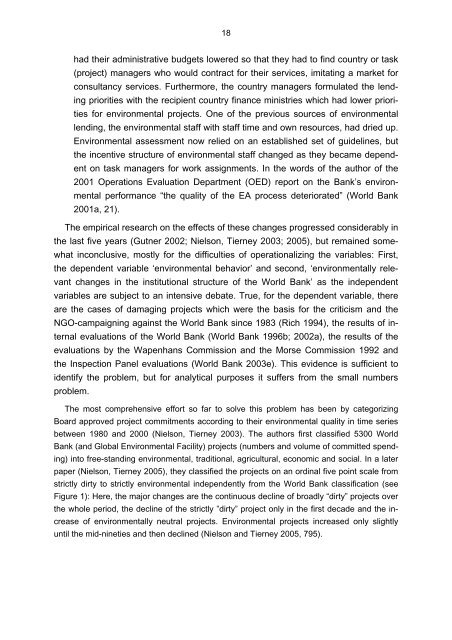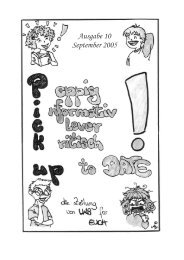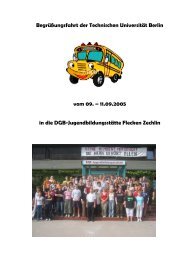Elegantes Telefax - JAV der TUB - TU Berlin
Elegantes Telefax - JAV der TUB - TU Berlin
Elegantes Telefax - JAV der TUB - TU Berlin
You also want an ePaper? Increase the reach of your titles
YUMPU automatically turns print PDFs into web optimized ePapers that Google loves.
18<br />
had their administrative budgets lowered so that they had to find country or task<br />
(project) managers who would contract for their services, imitating a market for<br />
consultancy services. Furthermore, the country managers formulated the lending<br />
priorities with the recipient country finance ministries which had lower priorities<br />
for environmental projects. One of the previous sources of environmental<br />
lending, the environmental staff with staff time and own resources, had dried up.<br />
Environmental assessment now relied on an established set of guidelines, but<br />
the incentive structure of environmental staff changed as they became dependent<br />
on task managers for work assignments. In the words of the author of the<br />
2001 Operations Evaluation Department (OED) report on the Bank’s environmental<br />
performance “the quality of the EA process deteriorated” (World Bank<br />
2001a, 21).<br />
The empirical research on the effects of these changes progressed consi<strong>der</strong>ably in<br />
the last five years (Gutner 2002; Nielson, Tierney 2003; 2005), but remained somewhat<br />
inconclusive, mostly for the difficulties of operationalizing the variables: First,<br />
the dependent variable ‘environmental behavior’ and second, ‘environmentally relevant<br />
changes in the institutional structure of the World Bank’ as the independent<br />
variables are subject to an intensive debate. True, for the dependent variable, there<br />
are the cases of damaging projects which were the basis for the criticism and the<br />
NGO-campaigning against the World Bank since 1983 (Rich 1994), the results of internal<br />
evaluations of the World Bank (World Bank 1996b; 2002a), the results of the<br />
evaluations by the Wapenhans Commission and the Morse Commission 1992 and<br />
the Inspection Panel evaluations (World Bank 2003e). This evidence is sufficient to<br />
identify the problem, but for analytical purposes it suffers from the small numbers<br />
problem.<br />
The most comprehensive effort so far to solve this problem has been by categorizing<br />
Board approved project commitments according to their environmental quality in time series<br />
between 1980 and 2000 (Nielson, Tierney 2003). The authors first classified 5300 World<br />
Bank (and Global Environmental Facility) projects (numbers and volume of committed spending)<br />
into free-standing environmental, traditional, agricultural, economic and social. In a later<br />
paper (Nielson, Tierney 2005), they classified the projects on an ordinal five point scale from<br />
strictly dirty to strictly environmental independently from the World Bank classification (see<br />
Figure 1): Here, the major changes are the continuous decline of broadly “dirty” projects over<br />
the whole period, the decline of the strictly ”dirty” project only in the first decade and the increase<br />
of environmentally neutral projects. Environmental projects increased only slightly<br />
until the mid-nineties and then declined (Nielson and Tierney 2005, 795).





